Assessing Granular Activated Carbon for Stormwater Pollutant Removal
VerifiedAdded on 2023/06/14
|48
|10398
|204
Report
AI Summary
This report investigates the use of granular activated carbon (GAC) filters for removing polycyclic aromatic hydrocarbons (PAHs) and heavy metals from stormwater. Batch and fixed-bed experiments were conducted to assess the removal efficiency of GAC under various conditions, including different filtration velocities and pH levels. Field studies demonstrated effective heavy metal removal at filtration velocities of 5-11.5 m/h with a 100 cm GAC column, enhanced by pre-treatment at higher velocities. The removal efficiency order was Pb, Cu > Zn, correlating with solubility product and hydrolysis constants. Kinetic models, such as homogenous particle diffusion and shell progressive models, were used to calculate intraparticle diffusion coefficients and mass transfer coefficients. The study concludes that GAC filters are a reliable method for removing heavy metals and PAHs from stormwater, offering valuable insights into optimizing water treatment processes.
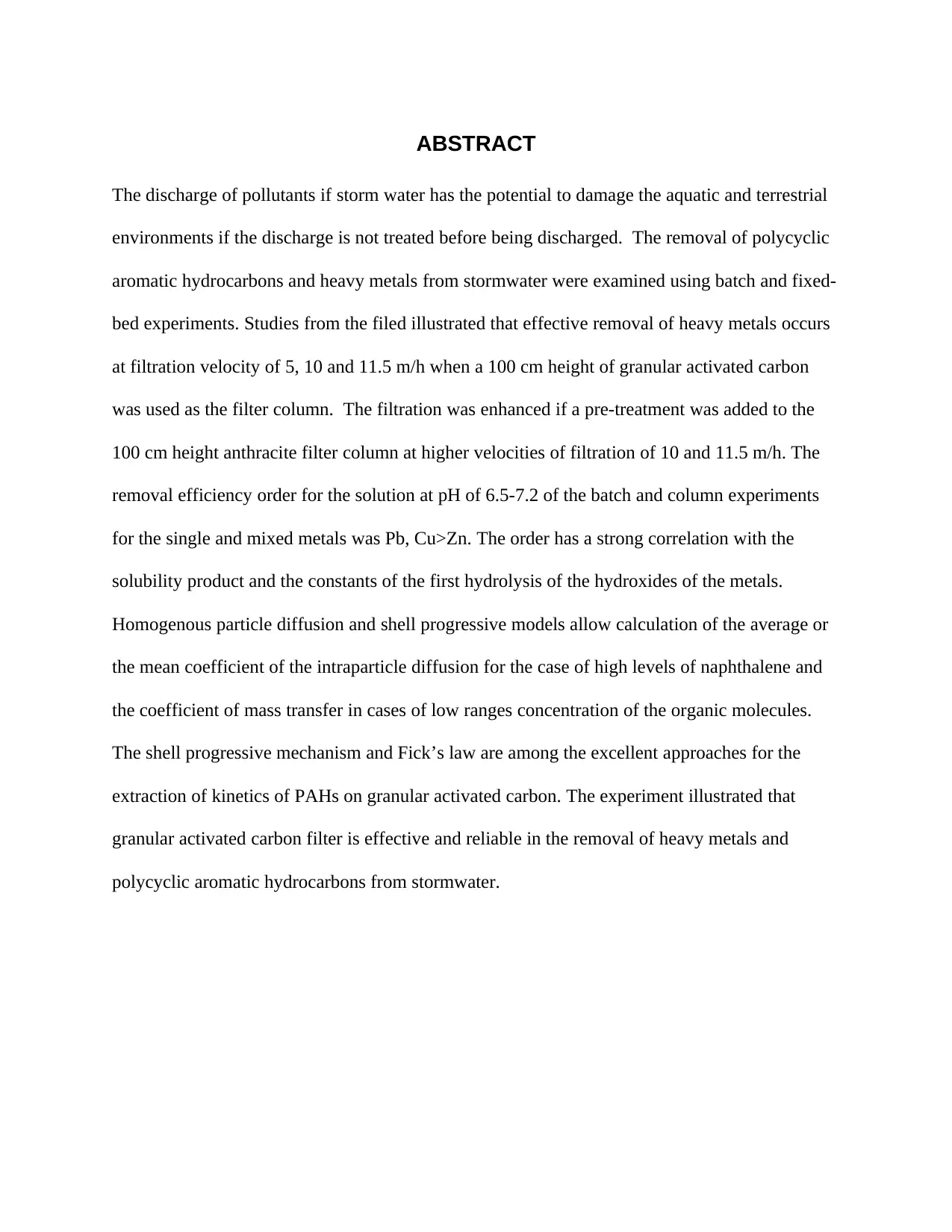
ABSTRACT
The discharge of pollutants if storm water has the potential to damage the aquatic and terrestrial
environments if the discharge is not treated before being discharged. The removal of polycyclic
aromatic hydrocarbons and heavy metals from stormwater were examined using batch and fixed-
bed experiments. Studies from the filed illustrated that effective removal of heavy metals occurs
at filtration velocity of 5, 10 and 11.5 m/h when a 100 cm height of granular activated carbon
was used as the filter column. The filtration was enhanced if a pre-treatment was added to the
100 cm height anthracite filter column at higher velocities of filtration of 10 and 11.5 m/h. The
removal efficiency order for the solution at pH of 6.5-7.2 of the batch and column experiments
for the single and mixed metals was Pb, Cu>Zn. The order has a strong correlation with the
solubility product and the constants of the first hydrolysis of the hydroxides of the metals.
Homogenous particle diffusion and shell progressive models allow calculation of the average or
the mean coefficient of the intraparticle diffusion for the case of high levels of naphthalene and
the coefficient of mass transfer in cases of low ranges concentration of the organic molecules.
The shell progressive mechanism and Fick’s law are among the excellent approaches for the
extraction of kinetics of PAHs on granular activated carbon. The experiment illustrated that
granular activated carbon filter is effective and reliable in the removal of heavy metals and
polycyclic aromatic hydrocarbons from stormwater.
The discharge of pollutants if storm water has the potential to damage the aquatic and terrestrial
environments if the discharge is not treated before being discharged. The removal of polycyclic
aromatic hydrocarbons and heavy metals from stormwater were examined using batch and fixed-
bed experiments. Studies from the filed illustrated that effective removal of heavy metals occurs
at filtration velocity of 5, 10 and 11.5 m/h when a 100 cm height of granular activated carbon
was used as the filter column. The filtration was enhanced if a pre-treatment was added to the
100 cm height anthracite filter column at higher velocities of filtration of 10 and 11.5 m/h. The
removal efficiency order for the solution at pH of 6.5-7.2 of the batch and column experiments
for the single and mixed metals was Pb, Cu>Zn. The order has a strong correlation with the
solubility product and the constants of the first hydrolysis of the hydroxides of the metals.
Homogenous particle diffusion and shell progressive models allow calculation of the average or
the mean coefficient of the intraparticle diffusion for the case of high levels of naphthalene and
the coefficient of mass transfer in cases of low ranges concentration of the organic molecules.
The shell progressive mechanism and Fick’s law are among the excellent approaches for the
extraction of kinetics of PAHs on granular activated carbon. The experiment illustrated that
granular activated carbon filter is effective and reliable in the removal of heavy metals and
polycyclic aromatic hydrocarbons from stormwater.
Paraphrase This Document
Need a fresh take? Get an instant paraphrase of this document with our AI Paraphraser
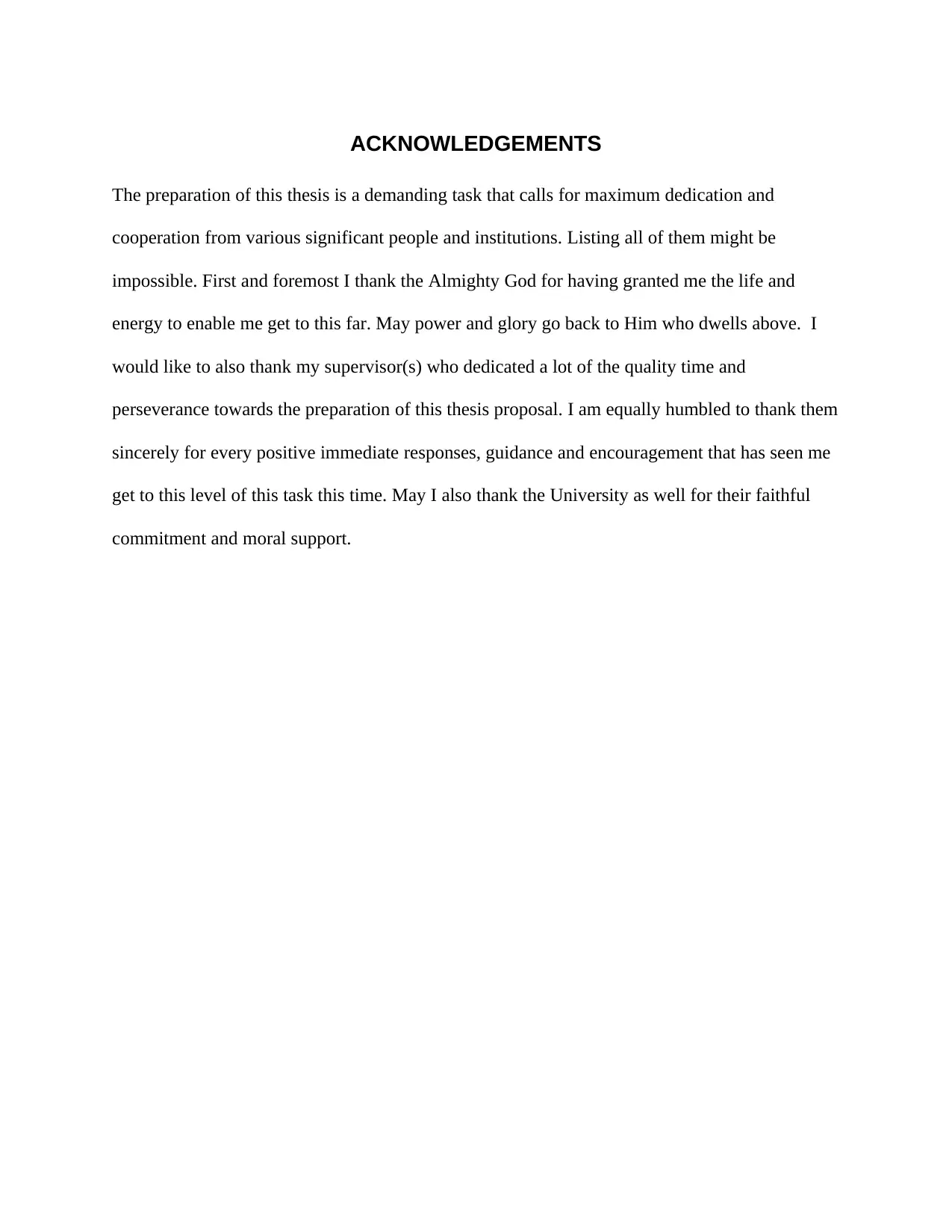
ACKNOWLEDGEMENTS
The preparation of this thesis is a demanding task that calls for maximum dedication and
cooperation from various significant people and institutions. Listing all of them might be
impossible. First and foremost I thank the Almighty God for having granted me the life and
energy to enable me get to this far. May power and glory go back to Him who dwells above. I
would like to also thank my supervisor(s) who dedicated a lot of the quality time and
perseverance towards the preparation of this thesis proposal. I am equally humbled to thank them
sincerely for every positive immediate responses, guidance and encouragement that has seen me
get to this level of this task this time. May I also thank the University as well for their faithful
commitment and moral support.
The preparation of this thesis is a demanding task that calls for maximum dedication and
cooperation from various significant people and institutions. Listing all of them might be
impossible. First and foremost I thank the Almighty God for having granted me the life and
energy to enable me get to this far. May power and glory go back to Him who dwells above. I
would like to also thank my supervisor(s) who dedicated a lot of the quality time and
perseverance towards the preparation of this thesis proposal. I am equally humbled to thank them
sincerely for every positive immediate responses, guidance and encouragement that has seen me
get to this level of this task this time. May I also thank the University as well for their faithful
commitment and moral support.

TABLE OF CONTENTS
ABSTRACT................................................................................................................................................................. 1
ACKNOWLEDGEMENTS....................................................................................................................................... 2
TABLE OF CONTENTS........................................................................................................................................... 3
LIST OF FIGURES.................................................................................................................................................... 4
LIST OF TABLES...................................................................................................................................................... 5
ABBREVIATIONS..................................................................................................................................................... 6
SYMBOLS.................................................................................................................................................................... 7
CHAPTER 1: INTRODUCTION............................................................................................................................ 8
CHAPTER 2: LITERATURE REVIEW................................................................................................................ 9
CHAPTER 3: EXPERIMENTAL METHODOLOGY...................................................................................... 14
Granular activated carbon anthracite..................................................................................................... 14
Heavy metals..................................................................................................................................................... 14
Stormwater........................................................................................................................................................ 15
Field fixed-bed column experiments....................................................................................................... 16
Laboratory batch experiments................................................................................................................... 17
Laboratory fixed-bed column experiments.......................................................................................... 18
Naphthalene....................................................................................................................................................... 20
Reagents and solutions................................................................................................................................. 20
Naphthalene analysis..................................................................................................................................... 21
Batch kinetics experiments......................................................................................................................... 21
SEM analysis...................................................................................................................................................... 22
Adsorption Studies.......................................................................................................................................... 22
Theoretical models of kinetics................................................................................................................... 23
CHAPTER 4: RESULTS AND DISCUSSION................................................................................................... 24
Laboratory batch experiments................................................................................................................... 24
Adsorption of heavy metal by granular activated charcoal............................................................24
Individual metals......................................................................................................................................... 24
ABSTRACT................................................................................................................................................................. 1
ACKNOWLEDGEMENTS....................................................................................................................................... 2
TABLE OF CONTENTS........................................................................................................................................... 3
LIST OF FIGURES.................................................................................................................................................... 4
LIST OF TABLES...................................................................................................................................................... 5
ABBREVIATIONS..................................................................................................................................................... 6
SYMBOLS.................................................................................................................................................................... 7
CHAPTER 1: INTRODUCTION............................................................................................................................ 8
CHAPTER 2: LITERATURE REVIEW................................................................................................................ 9
CHAPTER 3: EXPERIMENTAL METHODOLOGY...................................................................................... 14
Granular activated carbon anthracite..................................................................................................... 14
Heavy metals..................................................................................................................................................... 14
Stormwater........................................................................................................................................................ 15
Field fixed-bed column experiments....................................................................................................... 16
Laboratory batch experiments................................................................................................................... 17
Laboratory fixed-bed column experiments.......................................................................................... 18
Naphthalene....................................................................................................................................................... 20
Reagents and solutions................................................................................................................................. 20
Naphthalene analysis..................................................................................................................................... 21
Batch kinetics experiments......................................................................................................................... 21
SEM analysis...................................................................................................................................................... 22
Adsorption Studies.......................................................................................................................................... 22
Theoretical models of kinetics................................................................................................................... 23
CHAPTER 4: RESULTS AND DISCUSSION................................................................................................... 24
Laboratory batch experiments................................................................................................................... 24
Adsorption of heavy metal by granular activated charcoal............................................................24
Individual metals......................................................................................................................................... 24
⊘ This is a preview!⊘
Do you want full access?
Subscribe today to unlock all pages.

Trusted by 1+ million students worldwide
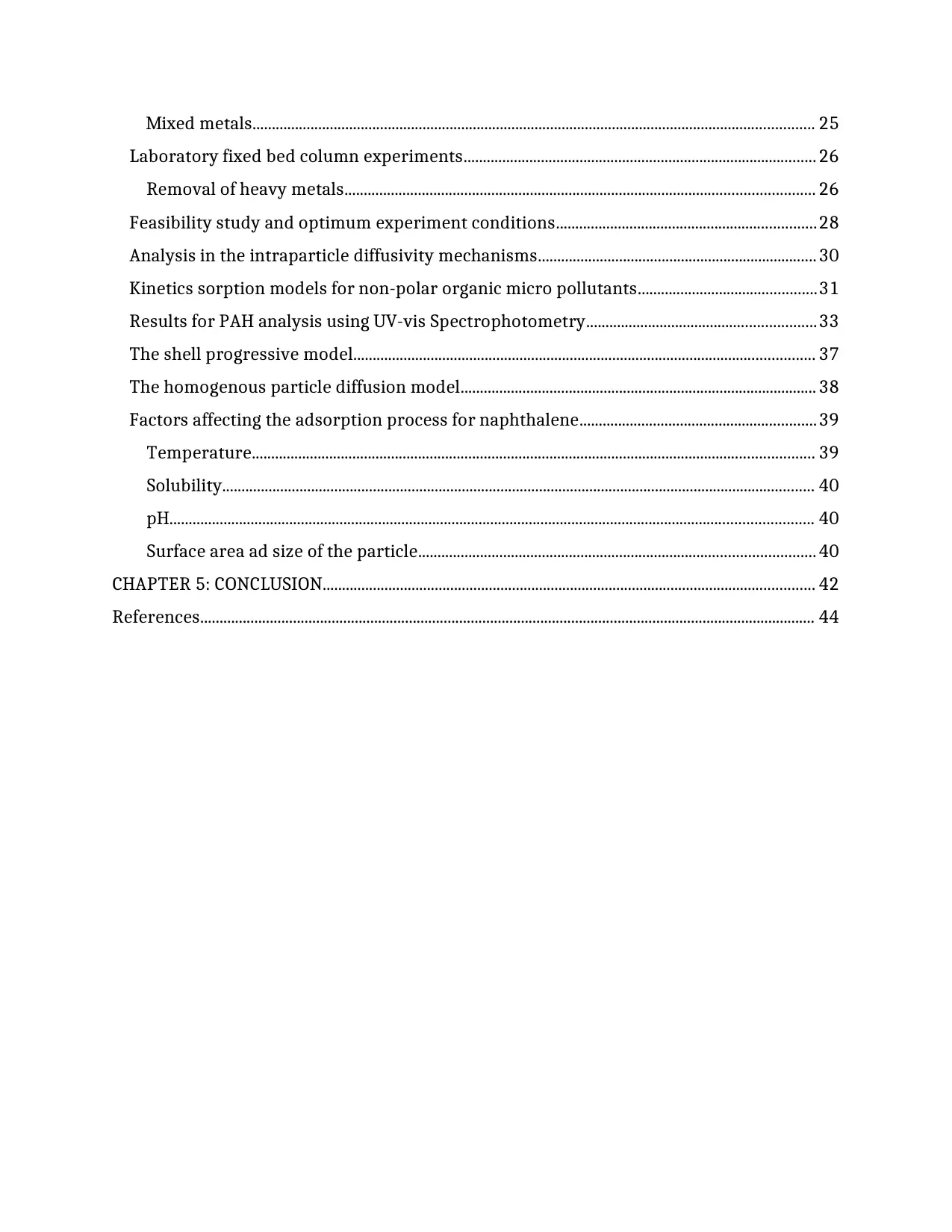
Mixed metals................................................................................................................................................. 25
Laboratory fixed bed column experiments........................................................................................... 26
Removal of heavy metals......................................................................................................................... 26
Feasibility study and optimum experiment conditions...................................................................28
Analysis in the intraparticle diffusivity mechanisms........................................................................ 30
Kinetics sorption models for non-polar organic micro pollutants..............................................31
Results for PAH analysis using UV-vis Spectrophotometry...........................................................33
The shell progressive model....................................................................................................................... 37
The homogenous particle diffusion model............................................................................................ 38
Factors affecting the adsorption process for naphthalene.............................................................39
Temperature................................................................................................................................................. 39
Solubility......................................................................................................................................................... 40
pH...................................................................................................................................................................... 40
Surface area ad size of the particle...................................................................................................... 40
CHAPTER 5: CONCLUSION............................................................................................................................... 42
References............................................................................................................................................................... 44
Laboratory fixed bed column experiments........................................................................................... 26
Removal of heavy metals......................................................................................................................... 26
Feasibility study and optimum experiment conditions...................................................................28
Analysis in the intraparticle diffusivity mechanisms........................................................................ 30
Kinetics sorption models for non-polar organic micro pollutants..............................................31
Results for PAH analysis using UV-vis Spectrophotometry...........................................................33
The shell progressive model....................................................................................................................... 37
The homogenous particle diffusion model............................................................................................ 38
Factors affecting the adsorption process for naphthalene.............................................................39
Temperature................................................................................................................................................. 39
Solubility......................................................................................................................................................... 40
pH...................................................................................................................................................................... 40
Surface area ad size of the particle...................................................................................................... 40
CHAPTER 5: CONCLUSION............................................................................................................................... 42
References............................................................................................................................................................... 44
Paraphrase This Document
Need a fresh take? Get an instant paraphrase of this document with our AI Paraphraser

LIST OF FIGURES
Figure 1: GAC filtration set-up schematic diagram………………………………………..…. 20
Figure 2: Concentrations of metals used in the experiment ……………………….….….……. 26
Figure 3: Efficiencies of the removal of mixed metals at different concentrations ….…..…..… 27
Figure 4: Curves for the column breakthrough for the three metals tested …………..…………28
Figure 5: Evolution of the concentration of naphthalene with respect to time ………….………29
Figure 6: Scanning examinations of the F400 …………………………………..……….…….. 31
Figure 7: Structure of Naphthalene …………………………………………………….………. 32
Figure 8: PAH analysis using UV-vis Spectrophotometry ………………….…………….…… 35
Figure 9: PAH analysis using UV-vis Spectrophotometry at 0 GAC ……………………...……36
Figure 10: PAH analysis using UV-vis Spectrophotometry at 0.1gm GAC ……….……………36
Figure 11: PAH analysis using UV-vis Spectrophotometry at 0.25gm GAC ……………….…..37
Figure 12: PAH analysis using UV-vis Spectrophotometry 0.75gm GAC ……………...…….. 37
Figure 13: PAH analysis using UV-vis Spectrophotometry 1gm GAC …………………..…… 38
Figure 1: GAC filtration set-up schematic diagram………………………………………..…. 20
Figure 2: Concentrations of metals used in the experiment ……………………….….….……. 26
Figure 3: Efficiencies of the removal of mixed metals at different concentrations ….…..…..… 27
Figure 4: Curves for the column breakthrough for the three metals tested …………..…………28
Figure 5: Evolution of the concentration of naphthalene with respect to time ………….………29
Figure 6: Scanning examinations of the F400 …………………………………..……….…….. 31
Figure 7: Structure of Naphthalene …………………………………………………….………. 32
Figure 8: PAH analysis using UV-vis Spectrophotometry ………………….…………….…… 35
Figure 9: PAH analysis using UV-vis Spectrophotometry at 0 GAC ……………………...……36
Figure 10: PAH analysis using UV-vis Spectrophotometry at 0.1gm GAC ……….……………36
Figure 11: PAH analysis using UV-vis Spectrophotometry at 0.25gm GAC ……………….…..37
Figure 12: PAH analysis using UV-vis Spectrophotometry 0.75gm GAC ……………...…….. 37
Figure 13: PAH analysis using UV-vis Spectrophotometry 1gm GAC …………………..…… 38
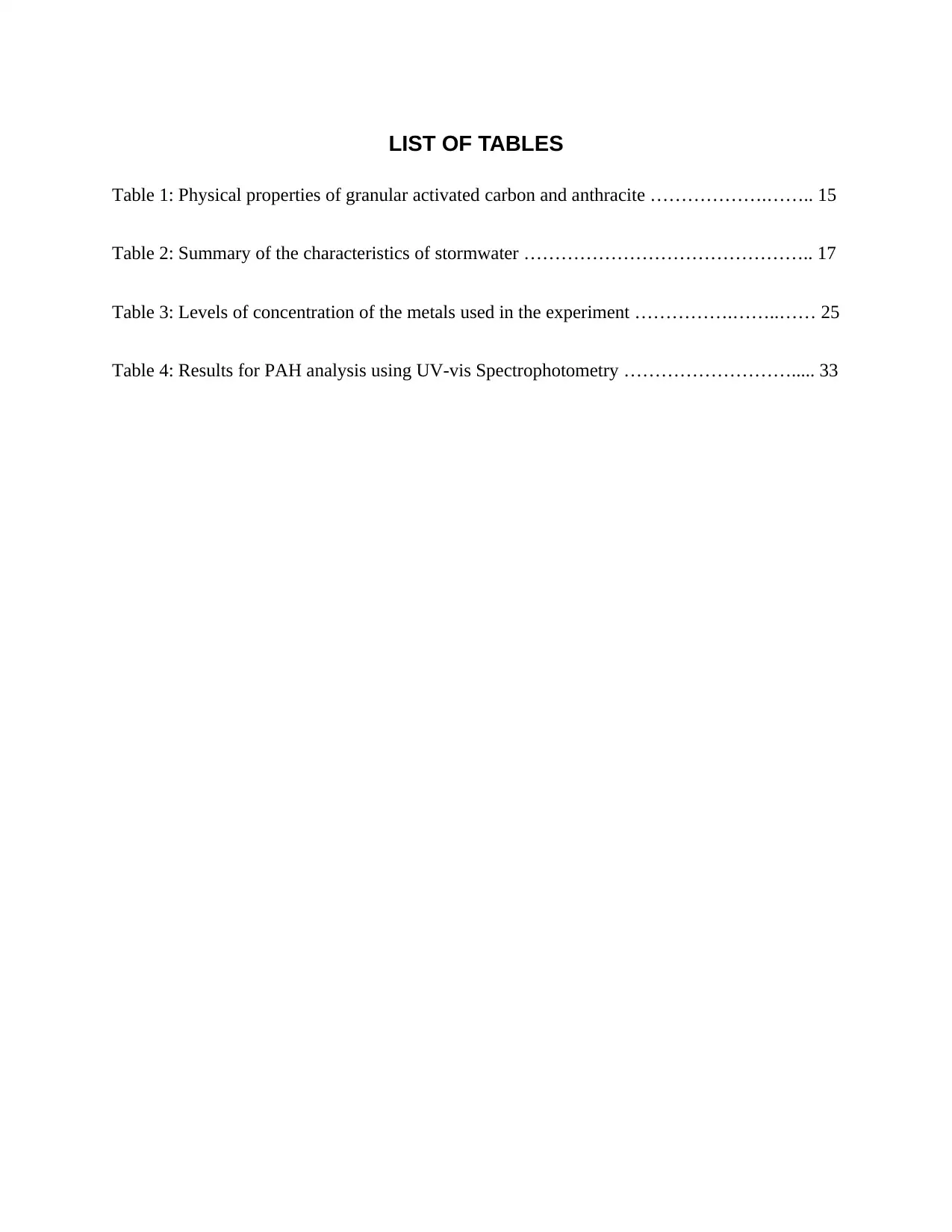
LIST OF TABLES
Table 1: Physical properties of granular activated carbon and anthracite ……………….…….. 15
Table 2: Summary of the characteristics of stormwater ……………………………………….. 17
Table 3: Levels of concentration of the metals used in the experiment …………….……..…… 25
Table 4: Results for PAH analysis using UV-vis Spectrophotometry ………………………..... 33
Table 1: Physical properties of granular activated carbon and anthracite ……………….…….. 15
Table 2: Summary of the characteristics of stormwater ……………………………………….. 17
Table 3: Levels of concentration of the metals used in the experiment …………….……..…… 25
Table 4: Results for PAH analysis using UV-vis Spectrophotometry ………………………..... 33
⊘ This is a preview!⊘
Do you want full access?
Subscribe today to unlock all pages.

Trusted by 1+ million students worldwide
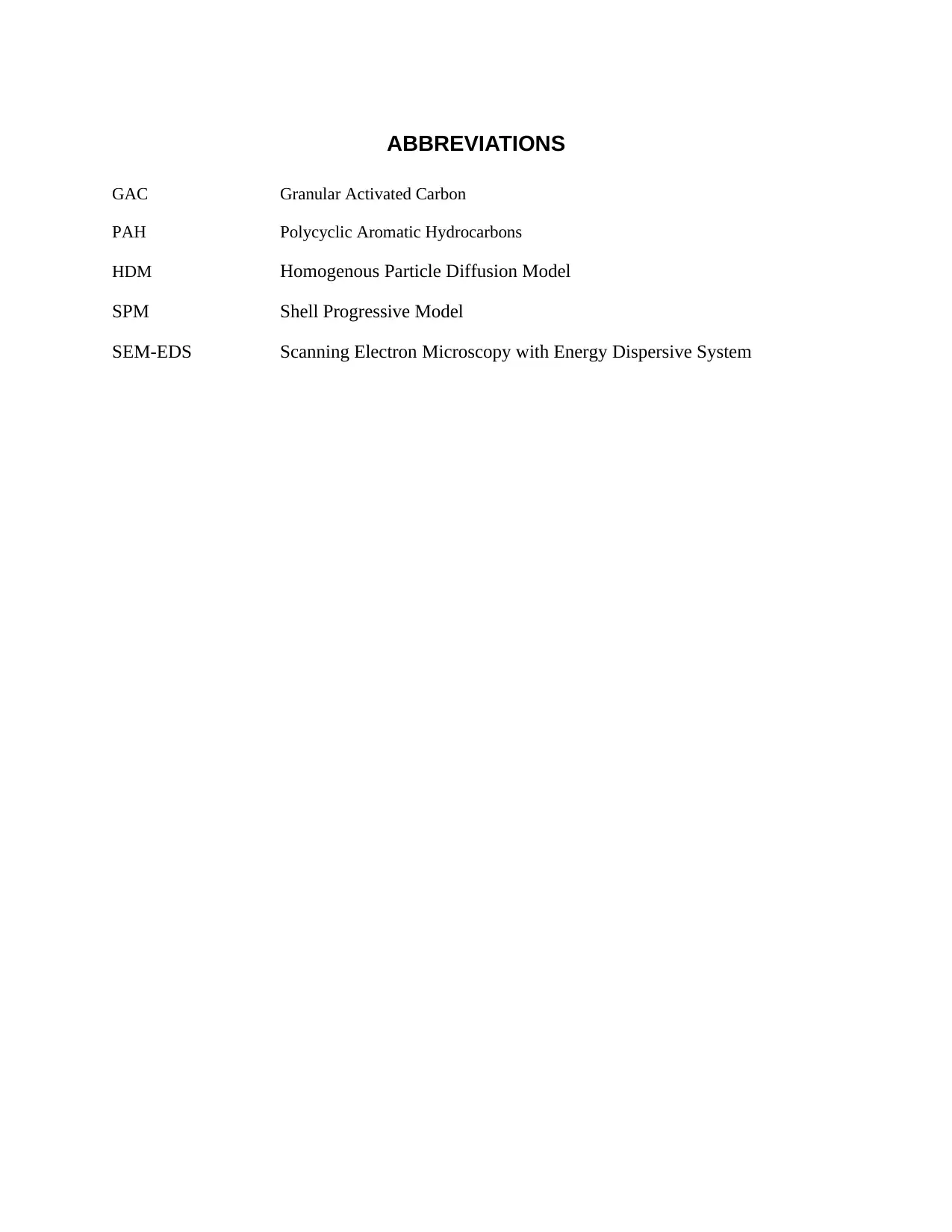
ABBREVIATIONS
GAC Granular Activated Carbon
PAH Polycyclic Aromatic Hydrocarbons
HDM Homogenous Particle Diffusion Model
SPM Shell Progressive Model
SEM-EDS Scanning Electron Microscopy with Energy Dispersive System
GAC Granular Activated Carbon
PAH Polycyclic Aromatic Hydrocarbons
HDM Homogenous Particle Diffusion Model
SPM Shell Progressive Model
SEM-EDS Scanning Electron Microscopy with Energy Dispersive System
Paraphrase This Document
Need a fresh take? Get an instant paraphrase of this document with our AI Paraphraser
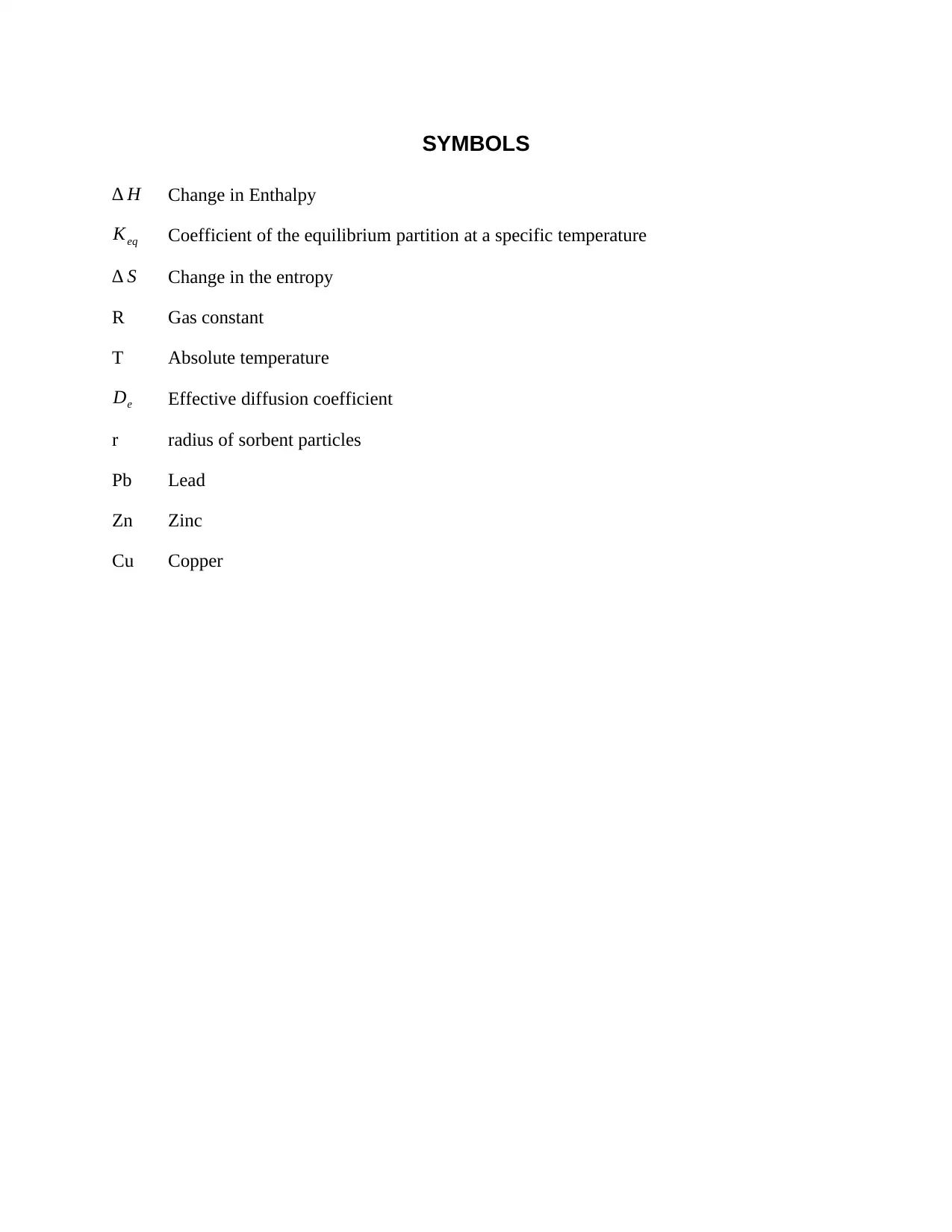
SYMBOLS
∆ H Change in Enthalpy
Keq Coefficient of the equilibrium partition at a specific temperature
∆ S Change in the entropy
R Gas constant
T Absolute temperature
De Effective diffusion coefficient
r radius of sorbent particles
Pb Lead
Zn Zinc
Cu Copper
∆ H Change in Enthalpy
Keq Coefficient of the equilibrium partition at a specific temperature
∆ S Change in the entropy
R Gas constant
T Absolute temperature
De Effective diffusion coefficient
r radius of sorbent particles
Pb Lead
Zn Zinc
Cu Copper
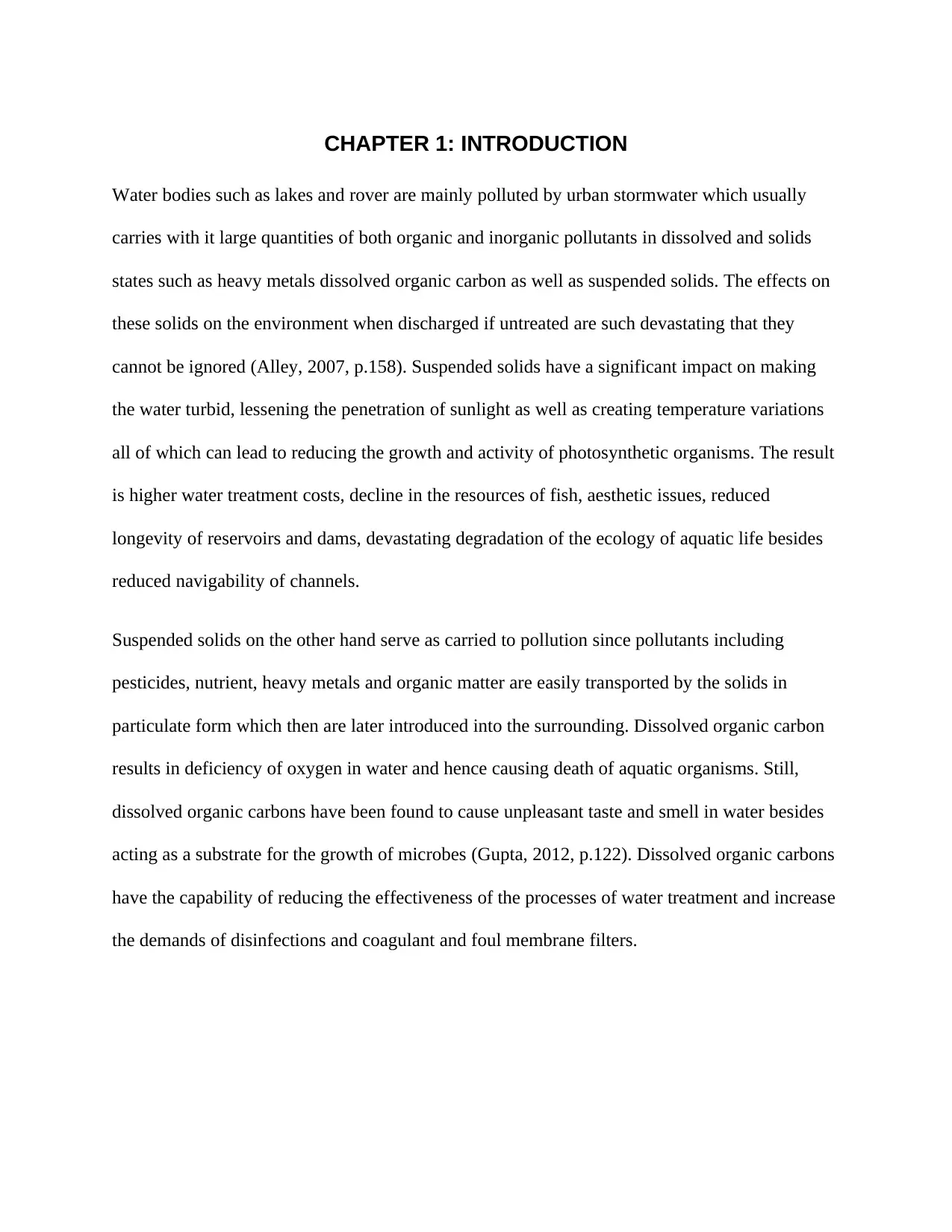
CHAPTER 1: INTRODUCTION
Water bodies such as lakes and rover are mainly polluted by urban stormwater which usually
carries with it large quantities of both organic and inorganic pollutants in dissolved and solids
states such as heavy metals dissolved organic carbon as well as suspended solids. The effects on
these solids on the environment when discharged if untreated are such devastating that they
cannot be ignored (Alley, 2007, p.158). Suspended solids have a significant impact on making
the water turbid, lessening the penetration of sunlight as well as creating temperature variations
all of which can lead to reducing the growth and activity of photosynthetic organisms. The result
is higher water treatment costs, decline in the resources of fish, aesthetic issues, reduced
longevity of reservoirs and dams, devastating degradation of the ecology of aquatic life besides
reduced navigability of channels.
Suspended solids on the other hand serve as carried to pollution since pollutants including
pesticides, nutrient, heavy metals and organic matter are easily transported by the solids in
particulate form which then are later introduced into the surrounding. Dissolved organic carbon
results in deficiency of oxygen in water and hence causing death of aquatic organisms. Still,
dissolved organic carbons have been found to cause unpleasant taste and smell in water besides
acting as a substrate for the growth of microbes (Gupta, 2012, p.122). Dissolved organic carbons
have the capability of reducing the effectiveness of the processes of water treatment and increase
the demands of disinfections and coagulant and foul membrane filters.
Water bodies such as lakes and rover are mainly polluted by urban stormwater which usually
carries with it large quantities of both organic and inorganic pollutants in dissolved and solids
states such as heavy metals dissolved organic carbon as well as suspended solids. The effects on
these solids on the environment when discharged if untreated are such devastating that they
cannot be ignored (Alley, 2007, p.158). Suspended solids have a significant impact on making
the water turbid, lessening the penetration of sunlight as well as creating temperature variations
all of which can lead to reducing the growth and activity of photosynthetic organisms. The result
is higher water treatment costs, decline in the resources of fish, aesthetic issues, reduced
longevity of reservoirs and dams, devastating degradation of the ecology of aquatic life besides
reduced navigability of channels.
Suspended solids on the other hand serve as carried to pollution since pollutants including
pesticides, nutrient, heavy metals and organic matter are easily transported by the solids in
particulate form which then are later introduced into the surrounding. Dissolved organic carbon
results in deficiency of oxygen in water and hence causing death of aquatic organisms. Still,
dissolved organic carbons have been found to cause unpleasant taste and smell in water besides
acting as a substrate for the growth of microbes (Gupta, 2012, p.122). Dissolved organic carbons
have the capability of reducing the effectiveness of the processes of water treatment and increase
the demands of disinfections and coagulant and foul membrane filters.
⊘ This is a preview!⊘
Do you want full access?
Subscribe today to unlock all pages.

Trusted by 1+ million students worldwide
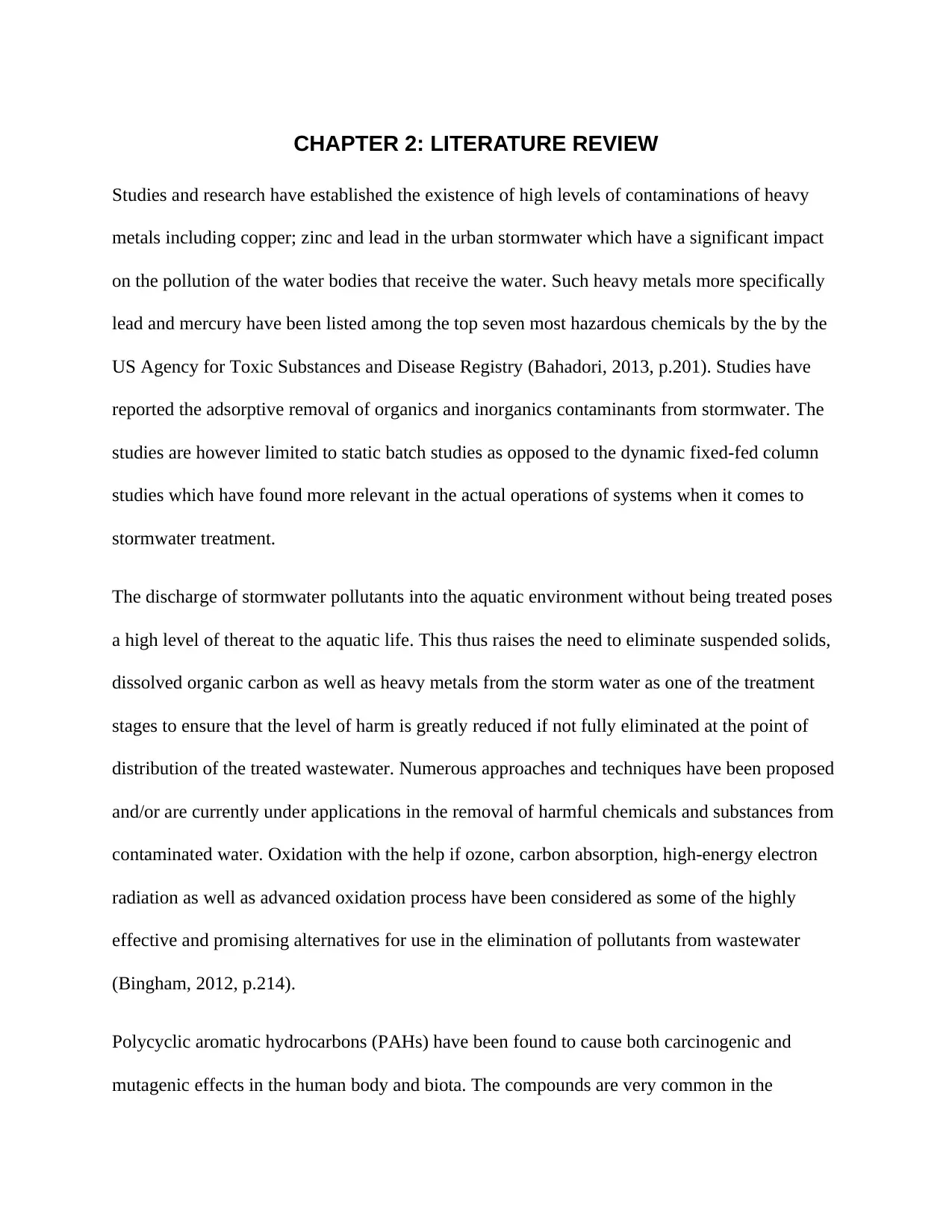
CHAPTER 2: LITERATURE REVIEW
Studies and research have established the existence of high levels of contaminations of heavy
metals including copper; zinc and lead in the urban stormwater which have a significant impact
on the pollution of the water bodies that receive the water. Such heavy metals more specifically
lead and mercury have been listed among the top seven most hazardous chemicals by the by the
US Agency for Toxic Substances and Disease Registry (Bahadori, 2013, p.201). Studies have
reported the adsorptive removal of organics and inorganics contaminants from stormwater. The
studies are however limited to static batch studies as opposed to the dynamic fixed-fed column
studies which have found more relevant in the actual operations of systems when it comes to
stormwater treatment.
The discharge of stormwater pollutants into the aquatic environment without being treated poses
a high level of thereat to the aquatic life. This thus raises the need to eliminate suspended solids,
dissolved organic carbon as well as heavy metals from the storm water as one of the treatment
stages to ensure that the level of harm is greatly reduced if not fully eliminated at the point of
distribution of the treated wastewater. Numerous approaches and techniques have been proposed
and/or are currently under applications in the removal of harmful chemicals and substances from
contaminated water. Oxidation with the help if ozone, carbon absorption, high-energy electron
radiation as well as advanced oxidation process have been considered as some of the highly
effective and promising alternatives for use in the elimination of pollutants from wastewater
(Bingham, 2012, p.214).
Polycyclic aromatic hydrocarbons (PAHs) have been found to cause both carcinogenic and
mutagenic effects in the human body and biota. The compounds are very common in the
Studies and research have established the existence of high levels of contaminations of heavy
metals including copper; zinc and lead in the urban stormwater which have a significant impact
on the pollution of the water bodies that receive the water. Such heavy metals more specifically
lead and mercury have been listed among the top seven most hazardous chemicals by the by the
US Agency for Toxic Substances and Disease Registry (Bahadori, 2013, p.201). Studies have
reported the adsorptive removal of organics and inorganics contaminants from stormwater. The
studies are however limited to static batch studies as opposed to the dynamic fixed-fed column
studies which have found more relevant in the actual operations of systems when it comes to
stormwater treatment.
The discharge of stormwater pollutants into the aquatic environment without being treated poses
a high level of thereat to the aquatic life. This thus raises the need to eliminate suspended solids,
dissolved organic carbon as well as heavy metals from the storm water as one of the treatment
stages to ensure that the level of harm is greatly reduced if not fully eliminated at the point of
distribution of the treated wastewater. Numerous approaches and techniques have been proposed
and/or are currently under applications in the removal of harmful chemicals and substances from
contaminated water. Oxidation with the help if ozone, carbon absorption, high-energy electron
radiation as well as advanced oxidation process have been considered as some of the highly
effective and promising alternatives for use in the elimination of pollutants from wastewater
(Bingham, 2012, p.214).
Polycyclic aromatic hydrocarbons (PAHs) have been found to cause both carcinogenic and
mutagenic effects in the human body and biota. The compounds are very common in the
Paraphrase This Document
Need a fresh take? Get an instant paraphrase of this document with our AI Paraphraser
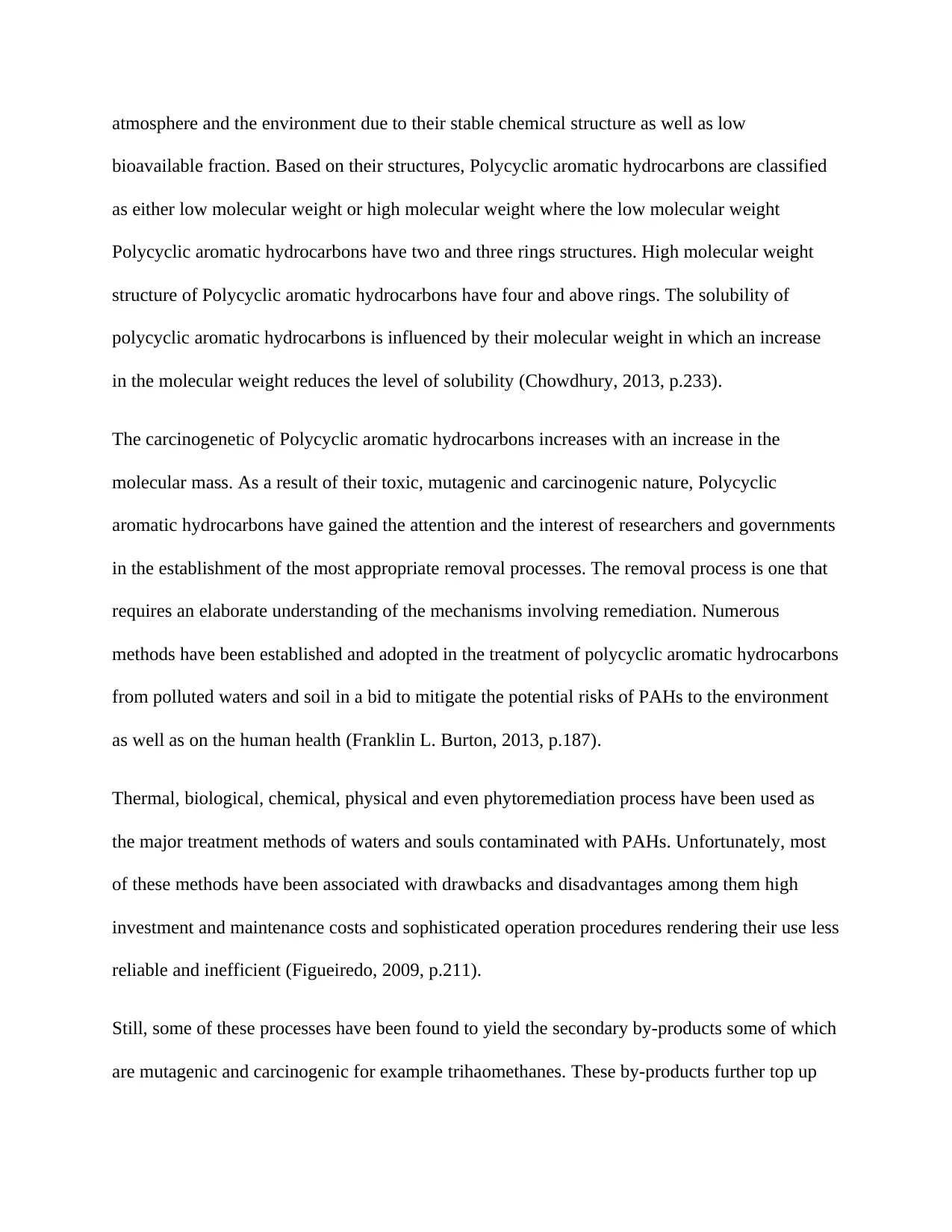
atmosphere and the environment due to their stable chemical structure as well as low
bioavailable fraction. Based on their structures, Polycyclic aromatic hydrocarbons are classified
as either low molecular weight or high molecular weight where the low molecular weight
Polycyclic aromatic hydrocarbons have two and three rings structures. High molecular weight
structure of Polycyclic aromatic hydrocarbons have four and above rings. The solubility of
polycyclic aromatic hydrocarbons is influenced by their molecular weight in which an increase
in the molecular weight reduces the level of solubility (Chowdhury, 2013, p.233).
The carcinogenetic of Polycyclic aromatic hydrocarbons increases with an increase in the
molecular mass. As a result of their toxic, mutagenic and carcinogenic nature, Polycyclic
aromatic hydrocarbons have gained the attention and the interest of researchers and governments
in the establishment of the most appropriate removal processes. The removal process is one that
requires an elaborate understanding of the mechanisms involving remediation. Numerous
methods have been established and adopted in the treatment of polycyclic aromatic hydrocarbons
from polluted waters and soil in a bid to mitigate the potential risks of PAHs to the environment
as well as on the human health (Franklin L. Burton, 2013, p.187).
Thermal, biological, chemical, physical and even phytoremediation process have been used as
the major treatment methods of waters and souls contaminated with PAHs. Unfortunately, most
of these methods have been associated with drawbacks and disadvantages among them high
investment and maintenance costs and sophisticated operation procedures rendering their use less
reliable and inefficient (Figueiredo, 2009, p.211).
Still, some of these processes have been found to yield the secondary by-products some of which
are mutagenic and carcinogenic for example trihaomethanes. These by-products further top up
bioavailable fraction. Based on their structures, Polycyclic aromatic hydrocarbons are classified
as either low molecular weight or high molecular weight where the low molecular weight
Polycyclic aromatic hydrocarbons have two and three rings structures. High molecular weight
structure of Polycyclic aromatic hydrocarbons have four and above rings. The solubility of
polycyclic aromatic hydrocarbons is influenced by their molecular weight in which an increase
in the molecular weight reduces the level of solubility (Chowdhury, 2013, p.233).
The carcinogenetic of Polycyclic aromatic hydrocarbons increases with an increase in the
molecular mass. As a result of their toxic, mutagenic and carcinogenic nature, Polycyclic
aromatic hydrocarbons have gained the attention and the interest of researchers and governments
in the establishment of the most appropriate removal processes. The removal process is one that
requires an elaborate understanding of the mechanisms involving remediation. Numerous
methods have been established and adopted in the treatment of polycyclic aromatic hydrocarbons
from polluted waters and soil in a bid to mitigate the potential risks of PAHs to the environment
as well as on the human health (Franklin L. Burton, 2013, p.187).
Thermal, biological, chemical, physical and even phytoremediation process have been used as
the major treatment methods of waters and souls contaminated with PAHs. Unfortunately, most
of these methods have been associated with drawbacks and disadvantages among them high
investment and maintenance costs and sophisticated operation procedures rendering their use less
reliable and inefficient (Figueiredo, 2009, p.211).
Still, some of these processes have been found to yield the secondary by-products some of which
are mutagenic and carcinogenic for example trihaomethanes. These by-products further top up
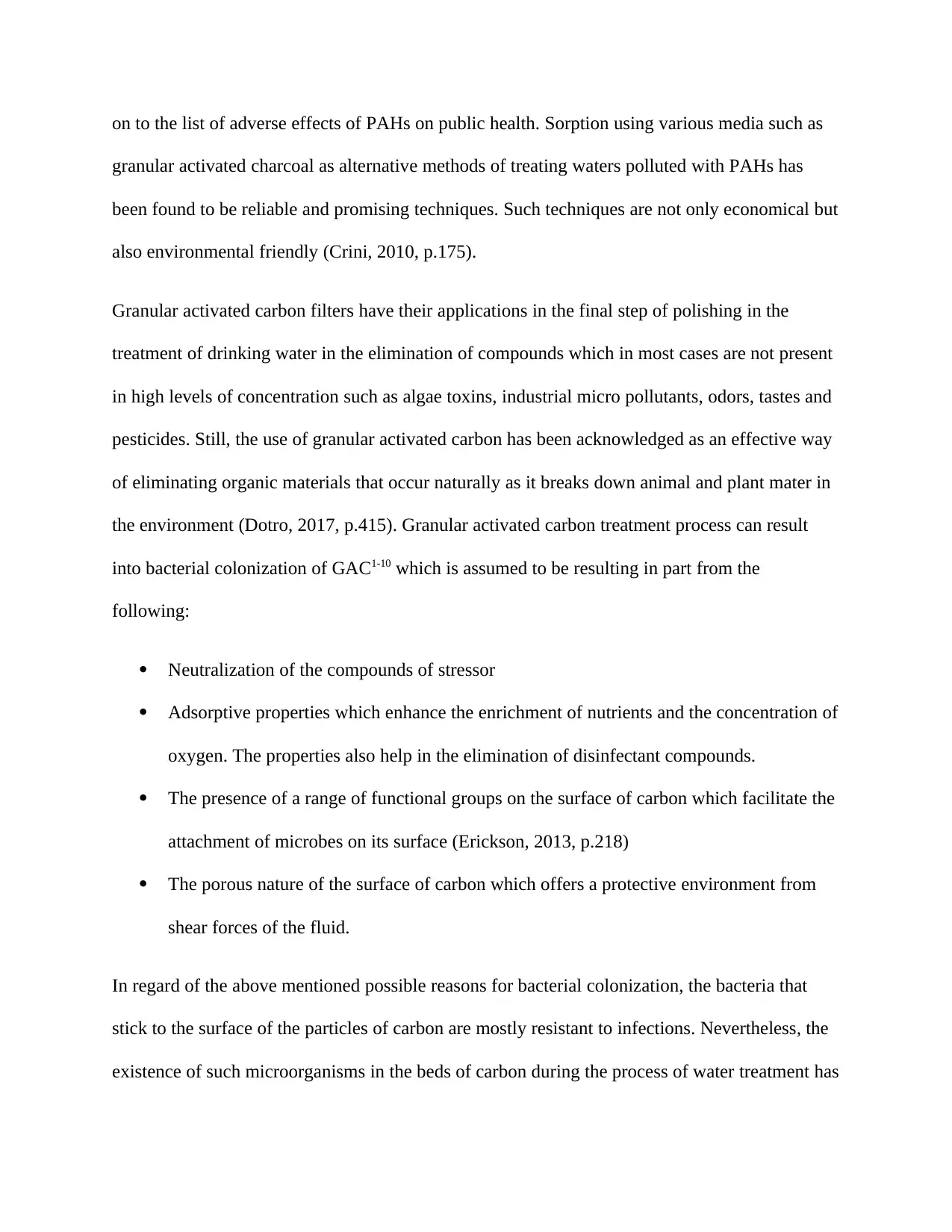
on to the list of adverse effects of PAHs on public health. Sorption using various media such as
granular activated charcoal as alternative methods of treating waters polluted with PAHs has
been found to be reliable and promising techniques. Such techniques are not only economical but
also environmental friendly (Crini, 2010, p.175).
Granular activated carbon filters have their applications in the final step of polishing in the
treatment of drinking water in the elimination of compounds which in most cases are not present
in high levels of concentration such as algae toxins, industrial micro pollutants, odors, tastes and
pesticides. Still, the use of granular activated carbon has been acknowledged as an effective way
of eliminating organic materials that occur naturally as it breaks down animal and plant mater in
the environment (Dotro, 2017, p.415). Granular activated carbon treatment process can result
into bacterial colonization of GAC1-10 which is assumed to be resulting in part from the
following:
Neutralization of the compounds of stressor
Adsorptive properties which enhance the enrichment of nutrients and the concentration of
oxygen. The properties also help in the elimination of disinfectant compounds.
The presence of a range of functional groups on the surface of carbon which facilitate the
attachment of microbes on its surface (Erickson, 2013, p.218)
The porous nature of the surface of carbon which offers a protective environment from
shear forces of the fluid.
In regard of the above mentioned possible reasons for bacterial colonization, the bacteria that
stick to the surface of the particles of carbon are mostly resistant to infections. Nevertheless, the
existence of such microorganisms in the beds of carbon during the process of water treatment has
granular activated charcoal as alternative methods of treating waters polluted with PAHs has
been found to be reliable and promising techniques. Such techniques are not only economical but
also environmental friendly (Crini, 2010, p.175).
Granular activated carbon filters have their applications in the final step of polishing in the
treatment of drinking water in the elimination of compounds which in most cases are not present
in high levels of concentration such as algae toxins, industrial micro pollutants, odors, tastes and
pesticides. Still, the use of granular activated carbon has been acknowledged as an effective way
of eliminating organic materials that occur naturally as it breaks down animal and plant mater in
the environment (Dotro, 2017, p.415). Granular activated carbon treatment process can result
into bacterial colonization of GAC1-10 which is assumed to be resulting in part from the
following:
Neutralization of the compounds of stressor
Adsorptive properties which enhance the enrichment of nutrients and the concentration of
oxygen. The properties also help in the elimination of disinfectant compounds.
The presence of a range of functional groups on the surface of carbon which facilitate the
attachment of microbes on its surface (Erickson, 2013, p.218)
The porous nature of the surface of carbon which offers a protective environment from
shear forces of the fluid.
In regard of the above mentioned possible reasons for bacterial colonization, the bacteria that
stick to the surface of the particles of carbon are mostly resistant to infections. Nevertheless, the
existence of such microorganisms in the beds of carbon during the process of water treatment has
⊘ This is a preview!⊘
Do you want full access?
Subscribe today to unlock all pages.

Trusted by 1+ million students worldwide
1 out of 48
Your All-in-One AI-Powered Toolkit for Academic Success.
+13062052269
info@desklib.com
Available 24*7 on WhatsApp / Email
![[object Object]](/_next/static/media/star-bottom.7253800d.svg)
Unlock your academic potential
Copyright © 2020–2025 A2Z Services. All Rights Reserved. Developed and managed by ZUCOL.